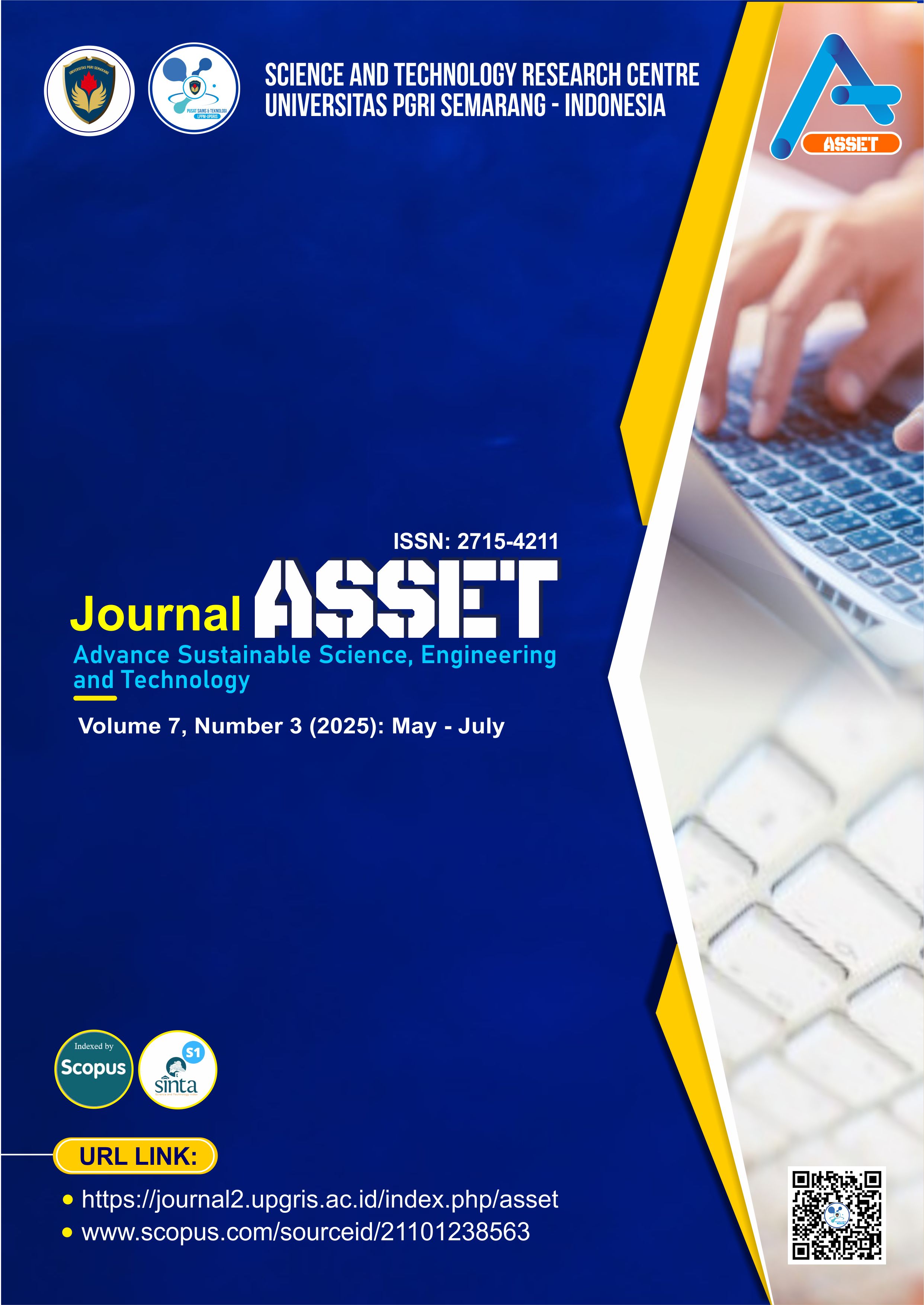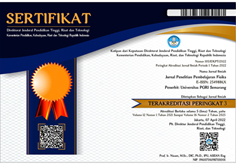Secure Visual Image Encryption Using Lorenz Chaos, Steganography, and Wavelet-Based Steganography Authentication
DOI:
https://doi.org/10.26877/asset.v7i4.2069Keywords:
chaos theory, digital image security, visual encryption, wavelet transform, image steganographyAbstract
Medical images play a vital role in diagnosis and clinical decision-making, yet their transmission and storage pose significant privacy and security challenges. This research proposes a visual stego-encryption system that integrates the Lorenz chaotic algorithm with Discrete Wavelet Transform (DWT) to embed both secret medical data and a doctor's digital signature into a visually meaningful encrypted image (VMEI). The system employs dual-layer embedding and role-based access control, allowing administrators to input patient and doctor data while enabling doctors to perform secure validation and decryption. A series of evaluation scenarios were conducted, including variations in image resolution, geometric transformations (rotation), Lorenz initial conditions, alpha embedding parameters, and multivariate optimization, along with user-role-based validation testing. Performance metrics based on Peak Signal-to-Noise Ratio (PSNR) and Bit Error Rate (BER) demonstrate that the system consistently achieves high visual fidelity (PSNR > 30 dB) and low data loss (BER ≈ 0) across all image types. The optimal configuration—using a 4096×4096 carrier, 1024×1024 secret, and 256×256 signature with α₁ = 0.28, α₂ = 0.07, and initial condition (0.2, 0.8, 1.5)—resulted in a PSNR of 33.01 dB for the secret image. These results confirm that the proposed system provides a robust, secure, and visually accurate method for medical image encryption, suitable for integration into real-world digital healthcare infrastructures.
References
[1] S. S. Kashyap, R. A. Dandekar, R. Dandekar, and S. Panat, “Modeling chaotic Lorenz ODE System using Scientific Machine Learning,” arXiv Prepr. arXiv2410.06452, 2024, doi: 10.48550/arXiv.2410.06452.
[2] A. Kouroubali and D. G. Katehakis, “Policy and strategy for interoperability of digital health in Europe,” in MEDINFO 2021: One World, One Health–Global Partnership for Digital Innovation, IOS Press, 2022, pp. 897–901.
[3] Z. Liu and R. Xue, “Medical image encryption using biometric image texture fusion,” J. Med. Syst., vol. 47, no. 1, p. 112, 2023.
[4] X. Huang, Y. Dong, G. Ye, W.-S. Yap, and B.-M. Goi, “Visually meaningful image encryption algorithm based on digital signature,” Digit. Commun. Networks, vol. 9, no. 1, pp. 159–165, 2023, doi: 10.1016/j.dcan.2022.04.028.
[5] S. Singh, V. Kumar, and H. K. Verma, “DWT–DCT hybrid scheme for medical image compression,” J. Med. Eng. Technol., vol. 31, no. 2, pp. 109–122, 2007.
[6] W. El-Shafai, F. Khallaf, E.-S. M. El-Rabaie, and F. E. A. El-Samie, “Robust medical image encryption based on DNA-chaos cryptosystem for secure telemedicine and healthcare applications,” J. Ambient Intell. Humaniz. Comput., vol. 12, no. 10, pp. 9007–9035, 2021.
[7] H. Chaudhary, P. Garg, and V. P. Vishwakarma, “Enhanced medical image watermarking using hybrid DWT-HMD-SVD and Arnold scrambling,” Sci. Rep., vol. 15, no. 1, p. 9710, 2025.
[8] A. Z. Hussain and M. A. A. Khodher, “Medical image encryption using multi chaotic maps,” TELKOMNIKA (Telecommunication Comput. Electron. Control., vol. 21, no. 3, pp. 556–565, 2023, doi: 10.12928/telkomnika.v21i3.24324.
[9] E. N. Lorenz, “Deterministic nonperiodic flow 1,” in Universality in Chaos, 2nd edition, Routledge, 2017, pp. 367–378.
[10] P. M. Bachiphale and N. S. Zulpe, “A comprehensive review of visual cryptography for enhancing high-security applications,” Multimed. Tools Appl., vol. 84, no. 26, pp. 31023–31045, 2025.
[11] J. Lee, O.-J. Kwon, Yaseen, and S. Choi, “A Watermark-Based Scheme for Authenticating JPEG 2000 Image Integrity That Complies with JPEG Privacy and Security,” Appl. Sci., vol. 14, no. 18, p. 8428, 2024.
[12] M. Pant, K. Ray, T. K. Sharma, S. Rawat, and A. Bandyopadhyay, “Soft computing: theories and applications,” Proc SoCTA, vol. 2, 2016.
[13] M. I. Bhat and K. J. Giri, “Impact of computational power on cryptography,” in Multimedia security: Algorithm development, analysis and applications, Springer, 2021, pp. 45–88.
[14] M. Nazeer, B. Nargis, Y. M. Malik, and D.-G. Kim, “A Fresnelet-based encryption of medical images using Arnold transform,” arXiv Prepr. arXiv1302.3702, 2013.
[15] B. Vaseghi, S. Mobayen, S. S. Hashemi, and A. Fekih, “Fast reaching finite time synchronization approach for chaotic systems with application in medical image encryption,” Ieee Access, vol. 9, pp. 25911–25925, 2021, doi: 10.1109/ACCESS.2021.3056037.
[16] J. Ibrahim and S. Gajin, “Entropy-based network traffic anomaly classification method resilient to deception,” Comput. Sci. Inf. Syst., vol. 19, no. 1, pp. 87–116, 2022.
[17] S. D. Mahmood, F. Drira, H. F. Mahdi, and A. M. Alimi, “Secure Medical Image Sharing: Technologies, Watermarking Insights, and Open Issues,” IEEE Access, 2025, doi: 10.1109/ACCESS.2025.3574477.
[18] V. Himthani, V. S. Dhaka, M. Kaur, D. Singh, and H.-N. Lee, “Systematic survey on visually meaningful image encryption techniques,” IEEE Access, vol. 10, pp. 98360–98373, 2022, doi: 10.1109/ACCESS.2022.3203173.
[19] Y. Su, H. Fang, F. Li, W. Xu, and X. Liu, “Visually meaningful image encryption based on human face biometric key,” Signal, Image Video Process., vol. 19, no. 14, p. 1182, 2025.
[20] T. Guo, T. Zhang, E. Lim, M. Lopez-Benitez, F. Ma, and L. Yu, “A review of wavelet analysis and its applications: Challenges and opportunities,” IEEe Access, vol. 10, pp. 58869–58903, 2022.
[21] M. S. R. Tanveer, K. Md. Rokibul Alam, and Y. Morimoto, “A multi-stage chaotic encryption technique for medical image,” Inf. Secur. J. A Glob. Perspect., vol. 31, no. 6, pp. 657–675, 2022.
[22] B. Schneier, Schneier’s Cryptography Classics Library: Applied Cryptography, Secrets and Lies, and Practical Cryptography. Wiley Publishing, 2007.
[23] V. Niharika, A. Sathvika, A. T. Kumar, and Y. Prasad, “SECURING DIAGNOSTIC TEXT DATA IN MEDICAL PHOTOGRAPHS: A NOVEL HYBRID APPROACH INTEGRATING AES-RSA ENCRYPTION AND 2D-DWT STEGANOGRAPHY,” J. Nonlinear Anal. Optim., vol. 15, no. 1, 2024.
[24] S. M. M. Khorzoughi, “Robust Watermarking for Magnetic Resonance Images with Automatic Region of Interest Detection.” Universiti Teknologi Malaysia, 2015.
[25] S. T. Ahmed, D. A. Hammood, R. F. Chisab, A. Al-Naji, and J. Chahl, “Medical image encryption: a comprehensive review,” Computers, vol. 12, no. 8, p. 160, 2023.











